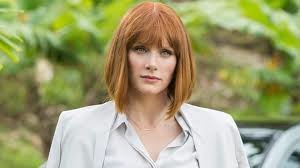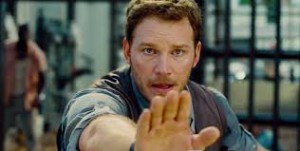Chayefsky’s Rule
This is our third post in succession about Theme in movies, plays, and books. I’m probably gonna do another six or seven over the coming weeks, so brace yourself. This stuff is important.

Bryce Dallas Howard in “Jurassic World.”
Let’s go back to that seminal quote from Paddy Chayefsky, cited two Wednesdays ago.
As soon as I figure out what my play is about, I type it out in one line and Scotch tape it to the front of my typewriter. After that, nothing goes into the play that is not on-theme.
Paddy might not approve if he knew I was about to use Jurassic World to illustrate his point. But let’s go for it.
The theme of all the Jurassic Park movies is Don’t Mess With Mother Nature. Let’s examine how the filmmakers of the latest in this series have followed Paddy’s precept.
First, the park-goers.
The crowds at Jurassic World could have been scripted or directed to act in any number of ways. They could have been mature, ecologically-minded, curious, respectful, well-behaved.
But that wouldn’t be on-theme. In fact it would clash with the theme. It wouldn’t fit, and we in the audience would feel that something was “off” and out of tune.
So the filmmakers made the crowds boisterous, boorish, and crude. They made their movements mob-like and unruly. They dressed them like rubes. They established their attitude toward the dinosaurs as one of condescension and exploitation, mixed with a measure of fear and self-titillation that only added to the vulgar, swinish quality of their characterization.
The crowds thought it was cool to mess with Mother Nature. They were having a blast ogling the captive, manufactured-for-spectacle dinosaurs.
In other words, the park-goers represent the counter-theme. They are the villain (or at least part of the villain.)
Then we have park management.
The execs at InGen obviously have no problem messing with Mother Nature. That’s the whole reason for the park. The science dudes want to push the envelope on genetic mutations. The investors want to make money. And the on-site managers hope to advance their careers.
The “nice” park executive is played by Bryce Dallas Howard. She’s at least trying to be responsible. She wants the show to go on. She wants everyone to have a good time. She doesn’t want anybody to be hurt.
She’s in the middle on the Mother Nature theme.
Next: Vic Hoskins (Vincent D’Onofrio) as chief of park security. His job is to secretly weaponize the raptors for war. He’s working for the man in all kinds of dark capacities. In other words, he really believes in messing with Mother Nature.
Finally we get to our hero, raptor wrangler Chris Pratt.
Chris is the only one who actually cares about the dinosaurs. When the Indominus Rex begins running amok, every other character is trying to save his or her butt or save the park or save the mega-dino to exploit further. Only Chris actually relates to the animals as fellow creatures.

Chris Pratt trying to reason with his raptor charges.
Hey, he says, what about them? They didn’t ask for this. They’re just doing what dinosaurs do. You guys uncorked the powers of Mother Nature. What did you expect would happen?
Chris is the hero. He represents the theme.
(And let’s not forget the dinosaurs. They’re the heroes too.)
A movie or a book is like a seduction. It’s like a legal brief, a sales pitch, a TED talk. If it’s going to work, it must be focused. It has to make one point—and make that point with all the concentrated power it can muster.
In the same way that an iPhone possesses unity, or a St. Laurent gown or a Ferarri Testarossa, a story must be structured to deliver one unified punch.
“Did he try any of that funny business with the trees?”
“I said he drove very nicely, Mother. Now, please, I asked him to stay close to the white line, and all, and he knew what I meant, and he did … “
This is Muriel, the young wife of Seymour Glass in J.D. Salinger’s A Perfect Day for Bananafish. Muriel and Seymour are on vacation at a beach hotel. Muriel is alone in Room 507.
“When I think of how you waited for that boy all through the war … ”
“Mother, we’d better hang up. Seymour may come in any minute.”
Outside, Seymour is wading into the ocean with another guest at the hotel, four-year-old Sybil Carpenter.
” … They lead a very tragic life,” he said. “You know what they do, Sybil?”
She shook her head.
“Well, they swim into a hole where there’s a lot of bananas. They’re very ordinary fish when they swim in. But once they get in, they behave like pigs. Why, I’ve known some bananafish to swim into a banana hole and eat as many as seventy-eight bananas … “
The theme of Bananafish is that war kills.
He got off at the fifth floor, walked down the hall, and let himself into 507. The room smelled of new calfskin luggage and nail-lacquer remover.
He glanced at the girl lying asleep on one of the twin beds. Then he went over to one of the pieces of luggage, opened it and from under a pile of shorts and undershirts took out an Ortgies calibre 7.65 automatic. He released the magazine, looked at it, then reinserted it. He cocked the piece. Then he went over and sat down on the unoccupied twin bed, looked at the girl, aimed the pistol, and fired a bullet through his right temple.
Dino flick or classic American short story, every element (as Paddy Chayefsky told us) must be on-theme.



